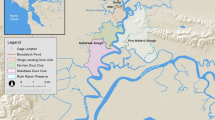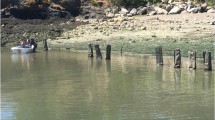Abstract
Out-migrating juvenile Chinook Salmon Oncorhynchus tshawytscha in California’s Central Valley lack frequent access to historical off-channel habitats such as floodplains. However, many regions have agricultural floodplains that may provide habitat value to young salmon. To determine the suitability of agricultural floodplain, this study tested whether winter-inundated rice fields in a historic flood basin in California’s Central Valley could provide adequate food resources for rearing juvenile Chinook Salmon. We examined the suitability of flooded rice fields for three post-harvest habitat types: stubble, fallow, and disced. Soil emergent and pelagic zooplankton communities were compared to determine colonization sources. Winter-inundated rice fields had high densities of zooplankton, which increased over the course of the study. Daphnia pulex, a large-bodied cladoceran and an excellent forage species of juvenile Chinook Salmon, was abundant in our study. Cladocerans colonized via source water while ostracods likely colonized from a soil egg bank. Overall, there was no discernable effect of habitat type on zooplankton community structure or density, except for D. pulex. Our results suggest that flooded agricultural rearing habitat can support juvenile Chinook Salmon based on high densities of zooplankton and other suitable habitat conditions have the potential to support a robust aquatic food web.





Similar content being viewed by others
References
Ackerman JT, Takekowa JY, Orthmeyer DL et al (2006) Spatial use by wintering greater white-fronted geese relative to a decade of habitat change in california’s central valley. J Wildl Manag 70:965–976
Aguilar-Alberola JA, Mesquita-Joanes F (2011) Population dynamics and tolerance to desiccation in a crustacean ostracod adapted to life in small ephemeral water bodies. Limnol Ecol Manag Inland Waters 41:348–355. doi:10.1016/j.limno.2011.03.003
Ahearn D, Viers JH, Mount JF, Dahlgren RA (2006) Priming the productivity pump: flood pulse driven trends in suspended algal biomass distribution across a restored floodplain. Freshw Biol 51:1417–1433. doi:10.1111/j.1365-2427.2006.01580.x
Allan JD (1976) Life history patterns in zooplankton. Am Nat 110:165–180
Baranyi C, Hein T, Holarek C et al (2002) Zooplankton biomass and community structure in a Danube River floodplain system: effects of hydrology. Freshw Biol 47:473–482. doi:10.1046/j.1365-2427.2002.00822.x
Bayley PB (1995) Understanding large river floodplain ecosystems. BioScience 45:153–158
Benigno GM, Sommer TR (2008) Just add water: sources of chironomid drift in a large river floodplain. Hydrobiologia 600:297–305. doi:10.1007/s10750-007-9239-2
Craddock DR, Blahm TH, Parente WD (1976) Occurrence and utilization of zooplankton by juvenile Chinook salmon in the Lower Columbia River. Trans Am Fish Soc 105:72–76. doi:10.1577/1548-8659(1976)105<72:OAUOZB>2.0.CO;2
Feyrer F, Sommer T, Harrell W (2006) Managing floodplain inundation for native fish: production dynamics of age-0 splittail (Pogonichthys macrolepidotus) in California’s Yolo Bypass. Hydrobiologia 573:213–226. doi:10.1007/s10750-006-0273-2
Frank PW, Boll CD, Kelly RW (1957) Vital statistics of laboratory cultures of Daphnia pule DeGeer as related to density. Physiol Zool 30:287–305
Gleason RA, Euliss NH, Hubbard DE, Duffy WG (2003) Effects of sediment load on emergence of aquatic invertebrates and plants from wetland soil egg and seed banks. Wetlands 23:26–34
Goss LB, Bunting DL (1983) Daphnia development and reproduction: responses to temperature. J Therm Biol 8:375–380. doi:10.1016/0306-4565(83)90025-6
Grosholz E, Gallo E (2006) The influence of flood cycle and fish predation on invertebrate production on a restored California floodplain. Hydrobiologia 568:91–109. doi:10.1007/s10750-006-0029-z
Hanak E, Lund J, Dinar A et al (2011) Managing California’s water: From conflict to reconcilation. Public Policy Institute of California, San Francisco
Havel JE, Eisenbacher EM, Black AA (2000) Diversity of crustacean zooplankton in riparian wetlands: colonization and egg banks. Aquat Ecol 34:63–76. doi:10.1023/A:1009918703131
Healy MC (1991) Life history of Chinook salmon. In: Groot C, Margolis L (eds) Pacific salmon life histories. UBC Press, Vancouver, pp 311–394
Humphries P, King AJ, Koehn JD (1998) Fish, flows and flood plains: links between freshwater fishes and their environment in the murray-Darling River System, Australia. Environ Biol Fishes 56:129–151. doi:10.1023/A:1007536009916
Jeffres CA, Opperman JJ, Moyle PB (2008) Ephemeral floodplain habitats provide best growth conditions for juvenile Chinook salmon in a California river. Environ Biol Fishes 83:449–458. doi:10.1007/s10641-008-9367-1
Junk WJ, Bayley PB, Sparks RE (1989) The flood pulse concept in river-floodplain systems. Proc Int Large River Symp Can Spec Publ Fish Aquat Sci 106:110–127
Katz JVE, Jeffres C, Conrad L, Sommer TR, Martinez J, Brumbaugh S, Corline N, Moyle PB (In Review) Floodplain farm fields provide novel rearing habitat for Chinook salmon: reconciling fish and farms in California. PLoS ONE
Koehler ME, Fresh KL, Beauchamp DA et al (2006) Diet and bioenergetics of lake-rearing juvenile Chinook salmon in Lake Washington. Trans Am Fish Soc 135:1580–1591. doi:10.1577/T05-178.1
Manatunge J, Asaeda T, Priyadarshana T (2000) The influence of structural complexity on fish–zooplankton interactions: a study using artificial submerged macrophytes. Environ Biol Fishes 58:425–438. doi:10.1023/A:1007691425268
Meerhoff M, Iglesias C, De Mello F et al (2007) Effects of habitat complexity on community structure and predator avoidance behaviour of littoral zooplankton in temperate versus subtropical shallow lakes. Freshw Biol 52:1009–1021. doi:10.1111/j.1365-2427.2007.01748.x
Merritt RW, Cummins K, Berg M (eds) (2008) An introduction to the Aquatic insects of North America, 4th edn. Kendall/Hunt Publishing Company, Dubuque
Merz JE (2002) Comparison of diets of prickly sculpin and juvenile fall-run Chinook salmon in the lower Mokelumne River, California. Southwest Nat 47:195–204
Mischke S (2013) I. Karanovic: recent freshwater ostracods of the world: Crustacea, Ostracoda, Podocopida. J Paleolimnol 49:707–708. doi:10.1007/s10933-013-9687-9
Mladenov N, McKnight DM, Wolski P, Ramberg L (2005) Effects of annual flooding on dissolved organic carbon dynamics within a pristine wetland, the Okavango Delta, Botswana. Wetlands 25:622–638
Opperman JJ, Luster R, McKenney BA et al (2010) Ecologically functional floodplains: connectivity, flow regime, and scale. JAWRA J Am Water Resour Assoc 46:211–226. doi:10.1111/j.1752-1688.2010.00426.x
Rondorf DW, Gray GA, Fairley RB (1990) Feeding ecology of subyearling Chinook salmon in riverine and reservoir habitats of the Columbia River. Trans Am Fish Soc 119:16–24. doi:10.1577/1548-8659(1990)119<0016:FEOSCS>2.3.CO;2
Salo J, Kalliola R, Hakkinen I et al (1986) River dynamics and the diversity of Amazon lowland forest. Nature 322:254–258
Satterthwaite WH, Hayes SA, Merz JE et al (2012) State-dependent migration timing and use of multiple habitat types in anadromous salmonids. Trans Am Fish Soc 141:781–794. doi:10.1080/00028487.2012.675912
Schemel LE, Sommer TR, Müller-Solger AB, Harrell WC (2004) Hydrologic variability, water chemistry, and phytoplankton biomass in a large floodplain of the Sacramento River, CA, U.S.A. Hydrobiologia 513:129–139. doi:10.1023/B:hydr.0000018178.85404.1c
Serrano L, Fahd K (2005) Zooplankton communities across a hydroperiod gradient of temporary ponds in the Doñana National Park (SW Spain). Wetlands 25:101–111
Sommer T, Harrell B, Nobriga M et al (2001a) California’s Yolo Bypass: evidence that flood control can be compatible with fisheries, wetlands, wildlife, and agriculture. Fisheries 26:6–16. doi:10.1577/1548-8446(2001)026<0006:CYB>2.0.CO;2
Sommer TR, Nobriga ML, Harrell WC et al (2001b) Floodplain rearing of juvenile Chinook salmon: evidence of enhanced growth and survival. Can J Fish Aquat Sci 58:325–333. doi:10.1139/cjfas-58-2-325
Sommer TR, Harrell WC, Solger AM et al (2004) Effects of flow variation on channel and floodplain biota and habitats of the Sacramento River, California, USA. Aquat Conserv Mar Freshw Ecosyst 14:247–261. doi:10.1002/aqc.620
Sommer TR, Harrell WC, Nobriga ML (2005) Habitat use and stranding risk of juvenile Chinook salmon on a seasonal floodplain. North Am J Fish Manag 25:1493–1504. doi:10.1577/M04-208.1
Sommer TR, Baxter RD, Feyrer F (2007) Splittail “Delisting”: a review of recent population trends and restoration activities. Am Fish Soc Symp 53:25–38
Tavernini S, Mura G, Rossetti G (2005) Factors influencing the seasonal phenology and composition of zooplankton communities in mountain temporary pools. Int Rev Hydrobiol 90:358–375. doi:10.1002/iroh.200510801
Thorp J, Covich A (eds) (2009) Ecology and classification of North American freshwater invertebrates, 3rd edn. Academic Press, Boston
Tockner K, Stanford JA (2002) Riverine flood plains: present state and future trends. Environ Conserv 29:308–330. doi:10.1017/S037689290200022X
Tronstad LM, Tronstad BP, Benke AC (2005) Invertebrate seedbanks: rehydration of soil from an unregulated river floodplain in the south-eastern U.S. Freshw Biol 50:646–655. doi:10.1111/j.1365-2427.2005.01351.x
Tronstad LM, Tronstad BP, Benke AC (2007) Aerial colonization and growth: rapid invertebrate responses to temporary aquatic habitats in a river floodplain. J N Am Benthol Soc 26:460–471. doi:10.1899/06-057.1
Unwin MJ (1997) Fry-to-adult survival of natural and hatchery-produced Chinook salmon (Oncorhynchus tshawytscha) from a common origin. Can J Fish Aquat Sci 54:1246–1254
Acknowledgements
We would like to thank Sharon Lawler and Peter Moyle for comments and insights that have greatly improved this paper. Support for this project was provided by the Center for Watershed Sciences University of California Davis, Cal Marsh and Farm, California Department of Water Resources and U.S. Bureau of Reclamation as part of the Interagency Ecological Program. We thank EcoAnalysts, Inc (Moscow, ID, USA) for assistance with invertebrate sorting and identification and the Dahlgren Water Quality Lab at UC Davis for water quality analysis. Additionally, we thank Miranda Tilcock, Angelica Munguia, Emma Cox, and Nicole Aha for tireless field and laboratory work.
Funding
Funding for this project was provided by California Trout.
Author information
Authors and Affiliations
Corresponding author
Rights and permissions
About this article
Cite this article
Corline, N.J., Sommer, T., Jeffres, C.A. et al. Zooplankton ecology and trophic resources for rearing native fish on an agricultural floodplain in the Yolo Bypass California, USA. Wetlands Ecol Manage 25, 533–545 (2017). https://doi.org/10.1007/s11273-017-9534-2
Received:
Accepted:
Published:
Issue Date:
DOI: https://doi.org/10.1007/s11273-017-9534-2




